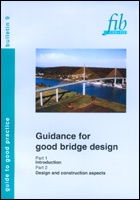Guidance for good bridge design (PDF)
Part 1 – Introduction.
Part 2 – Design and construction aspects.
Guide to good practice (190 pages, ISBN 978-2-88394-049-9, July 2000) - PDF format
fib Bulletin No. 09
Title: Guidance for good bridge design
Category: Guide to good practice
Year: 2000
Pages: 190
Format approx. DIN A4 (210x297 mm), 8 tables, 97 colour photos, 67 illustrations.
ISBN: 978-2-88394-049-9
DOI: doi.org/10.35789/fib.BULL.0009
Abstract: Part 1 – Introduction
Addressed to designers and even more so to owners and project managers, this part is meant as a guide to an efficient selection of designers and contractors, and to the preparation of fair contracts providing high quality at reasonable cost. Clearly, a good design must be paid for at its real cost; economising on the design cost can be extremely counterproductive for the owner when considering the final whole-life cost of the project. In addition, it was considered very important to address the designer’s responsibilities and relations with other participants in large projects, and finally design philosophy itself.
Part 2 – Design and construction aspects
This more technical part is mainly addressed to bridge designers and devoted to a systematic analysis of structural and constructional bridge concepts. Considering the importance of erection techniques in the development of bridge design, this second part of the guide starts by a description of the different construction methods, their advantages and draw-backs, their particularities and, of course, by defining the domain of their most efficient applications. Another main chapter is devoted to the proper design of cross-sections. And finally, a third main chapter deals in detail with the influence of construction techniques on design.
- Objective of a good design - doi.org/10.35789/fib.BULL.0009.Ch01
- Co-ordination with other aspects of the project, other than structural - doi.org/10.35789/fib.BULL.0009.Ch02
- Responsibilities, design and project management - doi.org/10.35789/fib.BULL.0009.Ch03
- Definition and costs of design - doi.org/10.35789/fib.BULL.0009.Ch04
- Design process and collection of data - doi.org/10.35789/fib.BULL.0009.Ch05
- Conceptual design - doi.org/10.35789/fib.BULL.0009.Ch06
- Philosophy of prestressing - doi.org/10.35789/fib.BULL.0009.Ch07
- Conclusion - doi.org/10.35789/fib.BULL.0009.Ch08
- Introduction - doi.org/10.35789/fib.BULL.0009.Ch09
- General comments on methods of construction - doi.org/10.35789/fib.BULL.0009.Ch10
- General comments on cross-sections - doi.org/10.35789/fib.BULL.0009.Ch11
- Influence of the method of construction on design - doi.org/10.35789/fib.BULL.0009.Ch12



